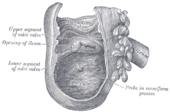appendix

|

|
| The caecum in detail, with the terminal ileum and ileocecal valve . The probe shows the entrance to the appendix . |
The cecum ( latin caecum , cecum or cecum , or intestine caecum , which derived the technical term cecum or cecum or eingedeutscht cecum or cecum ; Greek τυφλὸν ἔντερον typhlon enteron of τυφλός typhlos , German , blind ' and ἔντερον enteron , German , intestine' ) is the blindly ending beginning part of the large intestine , which at the end of the small intestine protrudes like a sack down into the abdominal cavity .
While the appendix, which is six to eight centimeters long and is located in the right middle abdomen in humans , is rather small, many herbivores (herbivores) have a sack-like elongated appendix. This is particularly the case with those herbivorous mammals that are unable to prepare their highly cellulosic food by ruminating . So one has Warmblood - domestic horse a cecum of one meter in length and about 30 liters.
In most mammals , the appendix lies on the right side of the abdominal cavity; An exception, however, are the old world pigs , where it is on the left.
In birds, the appendix is paired. For chicken and ducks birds the two appendices are relatively long and also take digestive sfunktionen while many pigeons - parrots - and passerines rudimentary are.
function
The popular belief that the appendix has no function in humans has been refuted by studies. The appendix is rich in lymphoid tissue in most species, especially in those with poor digestive functions. Therefore, the appendix also plays a major role in mediating immunity processes against antigens taken up through the digestive tract . It is therefore considered part of the immune system. There is also the thesis that after diarrhea, the “cleared” intestine is repopulated with intestinal bacteria starting from the appendix.
Herbivores (herbivores), which no ruminants are, have a highly developed appendicitis in order to implement non-cleavable organic nutritional compounds in food with the help of nutrient-splitting microorganisms absorbable nutrients. Examples in the animal world are horses , rhinos , pointed squirrels and rodents such as guinea pigs .
Anatomy in humans and other primates
In primates, the lower end of the appendix can be marked with a line drawn from the navel to the right front upper iliac spine, on which the so-called McBurney point is located between the outer and middle third of the line . Here - at the point where three longitudinal strips ( tänien ) of the appendix consisting of smooth muscles meet - is the point of departure of the appendix (Latin: appendix vermiformis ).
The lower end of the ileum (ileum) protrudes into the appendix as an ileo-caecal valve or Bauhin valve . When the appendix is stretched , this valve prevents bacteria from entering the less germ-free small intestine , the lower part of which is the ileum.
Clinic and diseases
Like the rest of the large intestine, the appendix can be examined using imaging techniques ( sonography , X-ray contrast imaging , computed tomography and nuclear magnetic resonance spectroscopy ), assessed directly using colonoscopy or palpated using palpation .
There are no diseases limited to the appendix as such in humans, with the exception of appendicitis ( appendicitis ). The latter can extend to the actual appendix and thus lead to appendicitis ( typhlitis ). In addition, diseases of the large or small intestine can also affect the appendix, e.g. B. an inflammation in regional enteritis Crohn or ulcerative colitis - here usually in the sense of pancolitis or ileocecal tuberculosis . In addition, tympanics , intussusception or twisting ( torsio caeci ) can occur.
Some parasites specialize in the appendix and can cause local inflammation ( typhlitis nodularis due to Heterakis ssp. And appendix coccidiosis in birds), which are mainly restricted to the appendix. When histomoniasis in poultry, especially appendix and liver (are typhlohepatitis ) affected. Certain bacteria such as Clostridium difficile can also lead to severe appendicitis in herbivores.
Web links
Individual evidence
- ↑ Werner Buselmaier: The gene-culture conflict. Springer-Verlag, 2016, ISBN 978-3-662-49395-3 , p. 54 ( limited preview in Google book search).
- ↑ M. Kirchgeßner among others: Animal nutrition. 12th, newly revised edition. DLG-Verlag, Frankfurt am Main 2008, ISBN 978-3-7690-0703-9 , p. 28.